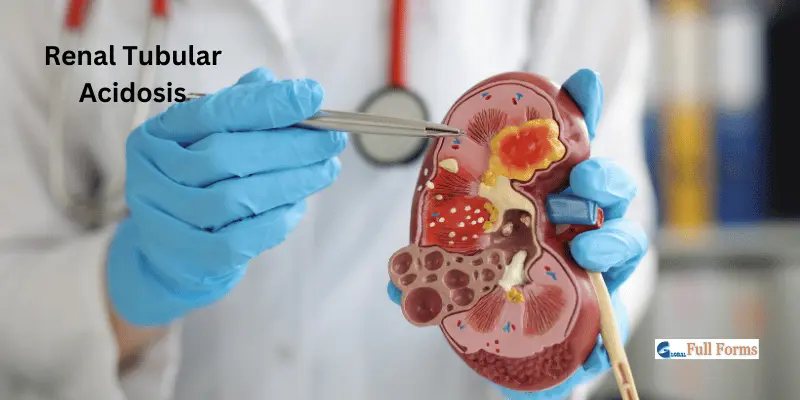RTA Full Form in Medical in English and Hindi
Published: March 23, 2025
If you’ve ever come across the RTA full form in medical discussions or reports, you might have wondered what it stands for.
Don’t worry, you’re not alone! Medical terms can sometimes be tricky to understand, especially when they’re shortened to acronyms.
In this article, we’ll break down the “RTA full form in medical” and explain what it means in simple terms.
Whether you’re a student, a patient, or just curious, this guide will give you a clear understanding of this important medical condition.
Let’s dive in!
What Does RTA Stand For?
In the medical field, “RTA” stands for Renal Tubular Acidosis. This is a condition that affects the kidneys, which are essential organs in the body responsible for filtering waste and maintaining a balance of fluids, salts, and minerals.
Renal Tubular Acidosis (RTA) refers to a disorder where the kidneys are unable to properly balance the body’s acid-base levels.
Normally, the kidneys excrete excess acid into the urine and reabsorb important substances like bicarbonate, which helps neutralize acids in the blood.
In someone with RTA, the kidneys fail to carry out one or both of these functions effectively.
As a result, acids build up in the bloodstream, leading to a condition called acidosis, which can be harmful over time.
The kidneys may not be able to excrete enough acid, or they may not be able to reabsorb enough bicarbonate, causing the body’s pH balance to shift.
This imbalance can lead to a variety of symptoms, ranging from mild fatigue and muscle weakness to more severe complications like kidney stones or bone disease if left untreated.
There are several types of Renal Tubular Acidosis, including:
- Type 1 (Distal RTA): In this form, the kidneys cannot effectively excrete acid into the urine.
- Type 2 (Proximal RTA): This type occurs when the kidneys cannot reabsorb bicarbonate properly.
- Type 4 (Hyperkalemic RTA): This type is linked to high potassium levels and often occurs due to a deficiency in the hormone aldosterone.
Understanding RTA is important, as it can help guide diagnosis and treatment, preventing further complications like kidney damage or growth issues in children.
Treatment often involves medications to restore the acid-base balance and address the underlying causes of the disorder.
In essence, RTA is a condition that highlights the crucial role the kidneys play in maintaining the body’s overall health, especially when it comes to balancing acidity.
RTA Full Form in Medical in English

The RTA full form in medical terms is Renal Tubular Acidosis. This is a condition that affects the kidneys and involves a disruption in the body’s acid-base balance.
The kidneys are vital organs responsible for filtering waste and excess substances from the blood, as well as maintaining a proper balance of electrolytes, fluids, and acids in the body.
In a healthy person, the kidneys help regulate the body’s acid-base balance by excreting excess hydrogen ions (acid) into the urine and reabsorbing bicarbonate (a base) into the blood.
However, in someone with Renal Tubular Acidosis, this process doesn’t function properly.
There are several causes for this, but the result is the same: the body’s pH balance becomes unregulated, leading to acidosis—an increase in the acidity of the blood.
There are different types of Renal Tubular Acidosis, and each type affects the kidneys’ ability to either excrete acid or reabsorb bicarbonate in different ways:
- Type 1 (Distal RTA): In this type, the kidneys fail to excrete enough acid into the urine, leading to an accumulation of acid in the blood. This can cause various symptoms such as muscle weakness, fatigue, or even bone problems if left untreated.
- Type 2 (Proximal RTA): Here, the issue lies with the kidneys’ inability to reabsorb bicarbonate from the urine back into the bloodstream. As a result, the blood loses its ability to neutralize excess acid, contributing to an acidic state in the body.
- Type 4 (Hyperkalemic RTA): This form of RTA is often related to an imbalance in the potassium levels, typically caused by a deficiency in the hormone aldosterone. In this case, the kidneys are unable to maintain proper potassium levels, which can lead to complications such as high potassium levels in the blood.
Each type of Renal Tubular Acidosis can have varying degrees of severity, and the symptoms can range from mild to serious.
Some of the common signs of RTA include fatigue, muscle weakness, growth problems in children, kidney stones, and bone disease.
In some cases, RTA can also lead to chronic kidney disease if not managed properly.
Treatment for RTA generally involves addressing the underlying causes of the condition and restoring the body’s acid-base balance.
This is typically done through medications such as bicarbonate supplements, which help neutralize the excess acid in the blood.
Monitoring kidney function and electrolyte levels is also essential for managing the condition effectively.
In summary, Renal Tubular Acidosis (RTA) is a medical condition that disrupts the kidneys’ normal function of regulating the body’s acid-base balance.
If untreated, it can lead to a variety of health issues, but with proper treatment and care, many individuals with R T A can manage the condition and prevent long-term complications.
R T A Full Form in Medical in Hindi
मेडिकल के संदर्भ में, RTA का पूरा रूप है रेनल ट्यूबुलर एसीडोसिस। यह एक ऐसी चिकित्सा स्थिति है जिसमें गुर्दे (किडनी) शरीर के अम्ल-क्षारीय संतुलन को ठीक से बनाए रखने में असमर्थ हो जाते हैं। हमारे शरीर के लिए यह संतुलन बहुत महत्वपूर्ण होता है, क्योंकि यह हमारे खून के pH स्तर को नियंत्रित करता है। जब इस संतुलन में गड़बड़ी होती है, तो शरीर में अधिक अम्ल (acid) जमा हो सकता है, जिससे स्वास्थ्य समस्याएं पैदा हो सकती हैं।
गुर्दे सामान्यत: रक्त से अतिरिक्त अम्ल को मूत्र के माध्यम से निकालने और बाइकार्बोनेट (जो एक क्षारीय पदार्थ है) को रक्त में फिर से अवशोषित करने का काम करते हैं। लेकिन जब किसी व्यक्ति को रेनल ट्यूबुलर एसीडोसिस (RTA) होता है, तो इन प्रक्रियाओं में गड़बड़ी हो जाती है। इसके परिणामस्वरूप, शरीर में अम्ल की अधिकता हो जाती है, जिससे रक्त में अम्लीयता बढ़ जाती है, जिसे एसीडोसिस कहा जाता है।
रेनल ट्यूबुलर एसीडोसिस के विभिन्न प्रकार होते हैं, जिनमें से प्रमुख हैं:
- प्रकार 1 (Distal RTA): इस प्रकार में, गुर्दे पर्याप्त मात्रा में अम्ल को मूत्र में नहीं निकाल पाते हैं, जिससे रक्त में अम्ल की अधिकता हो जाती है। इसके कारण मांसपेशियों में कमजोरी, थकान और हड्डियों की समस्याएं हो सकती हैं।
- प्रकार 2 (Proximal RTA): इस प्रकार में, गुर्दे बाइकार्बोनेट को मूत्र से अवशोषित नहीं कर पाते हैं। बाइकार्बोनेट रक्त में पिओर अम्ल को संतुलित करने में मदद करता है, और इसके अभाव में शरीर में अम्लीयता बढ़ जाती है।
- प्रकार 4 (Hyperkalemic RTA): इस प्रकार का RTA अक्सर पोटेशियम के स्तर के असंतुलन के कारण होता है, जो विशेष रूप से एल्डोस्टेरोन नामक हार्मोन की कमी के कारण होता है। इस प्रकार के RTA में, शरीर में पोटेशियम का स्तर अधिक बढ़ सकता है, जो अन्य स्वास्थ्य समस्याओं का कारण बन सकता है।
रेनल ट्यूबुलर एसीडोसिस के लक्षणों में थकान, मांसपेशियों में कमजोरी, हड्डियों में दर्द, बच्चों में विकास की समस्या, और किडनी स्टोन जैसी समस्याएं शामिल हो सकती हैं। यदि इसे समय पर ठीक न किया जाए, तो यह किडनी की स्थायी क्षति का कारण बन सकता है।
उपचार के लिए, आमतौर पर बाइकार्बोनेट जैसी दवाओं का उपयोग किया जाता है, जो रक्त में अम्ल की अधिकता को संतुलित करने में मदद करती है। साथ ही, गुर्दे की कार्यप्रणाली और शरीर में इलेक्ट्रोलाइट्स के स्तर की निगरानी भी की जाती है। इसके अलावा, रोग के कारणों को समझकर उनका इलाज किया जाता है, जैसे कि जीन विकार या दवाओं के दुष्प्रभाव।
निष्कर्ष के रूप में, रेनल ट्यूबुलर एसीडोसिस (RTA) एक गंभीर स्वास्थ्य स्थिति है, जिसे उचित उपचार और ध्यान से नियंत्रित किया जा सकता है। समय पर इलाज से शरीर के अम्लीयता को नियंत्रित किया जा सकता है और किडनी की क्षति से बचा जा सकता है।
FAQs
Renal Tubular Acidosis (RTA) is a condition in which the kidneys are unable to properly regulate the body’s acid-base balance. This leads to an accumulation of acid in the blood, resulting in a condition called acidosis. The kidneys fail to excrete enough acid or reabsorb sufficient bicarbonate, which is necessary to neutralize the acids in the body.
Symptoms of Renal Tubular Acidosis can vary depending on the severity and type of the condition. Common symptoms include:
Fatigue or weakness
Muscle weakness or cramps
Bone pain or growth problems in children
Kidney stones
Frequent urination and increased thirst
Poor appetite and nausea in severe cases
RTA can be caused by a variety of factors, including:
Genetic disorders (such as familial RTA)
Chronic kidney diseases
Side effects of certain medications (like diuretics)
Autoimmune diseases
Disorders affecting electrolyte balance, like low aldosterone levels
Infections or conditions that impair kidney function
Diagnosis of RTA typically involves several tests, including:
Blood tests to measure levels of bicarbonate and acids in the blood
Urine tests to check for abnormal acid or bicarbonate levels
Kidney function tests to assess how well the kidneys are working
In some cases, a kidney biopsy may be needed to confirm the type of RTA.
Yes, Renal Tubular Acidosis is treatable, though treatment depends on the underlying cause and the type of RTA. Common treatments include:
Bicarbonate supplements to help neutralize excess acid in the blood
Medications to address the underlying causes, such as hormone replacement for aldosterone deficiency
Monitoring and managing electrolyte imbalances
In some cases, if kidney damage is severe, dialysis or a kidney transplant may be necessary.
Conclusion
Renal Tubular Acidosis (RTA) is a condition where the kidneys are unable to properly manage the body’s acid-base balance, leading to an excess of acid in the blood.
This can cause symptoms like fatigue, muscle weakness, and kidney stones. While it may sound complicated, with proper diagnosis and treatment, RTA can be managed effectively.
Treatment usually involves medications to restore balance and address underlying causes.
If you or someone you know is experiencing symptoms, it’s important to consult a healthcare provider to ensure timely care and prevent long-term complications.
With the right treatment, people with RTA can lead healthy lives.
Extra Points on Renal Tubular Acidosis (RTA)
- Monitoring is Key: People with RTA need regular check-ups to monitor kidney function and electrolyte levels. This helps to catch any issues early and adjust treatment as needed.
- Diet and Lifestyle: A balanced diet rich in fruits and vegetables can help manage symptoms. Sometimes, a doctor might suggest dietary changes to support kidney function and prevent complications like kidney stones.
- Impact on Children: In children, RTA can affect growth, so early detection and treatment are especially important. With the right care, kids can grow and develop normally.
- Prevention: While some causes of RTA are genetic or due to underlying diseases, maintaining good kidney health through hydration, a healthy diet, and avoiding harmful medications can help reduce the risk.
- By understanding these extra points, you can see that Renal Tubular Acidosis, while serious, can be effectively managed with the right care and attention.

- Be Respectful
- Stay Relevant
- Stay Positive
- True Feedback
- Encourage Discussion
- Avoid Spamming
- No Fake News
- Don't Copy-Paste
- No Personal Attacks

- Be Respectful
- Stay Relevant
- Stay Positive
- True Feedback
- Encourage Discussion
- Avoid Spamming
- No Fake News
- Don't Copy-Paste
- No Personal Attacks





